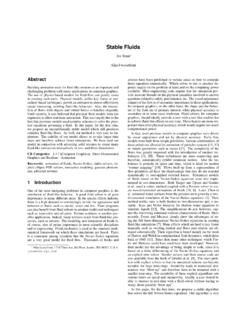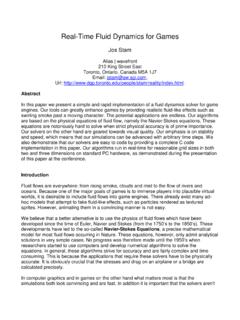Transcription of The Fundamental Principles of Animation
1 Tutorial #11 Prepared by Gustavo CarneiroThis tutorial was based on the Notes by P. Coleman,on the web-page ,and on the paper Principles of Traditional Animation Applied to 3D ComputerAnimation . By J. Lasseter, Pixar, San Rafael, California. In ACM Computer Graphics(21), 4, July Fundamental Principles of AnimationIt all started after the 30s when Walt Disney noticed that the level of Animation wasinadequate for some new story lines. Classes for his animators were set up under theinstruction of Don Graham. Before those classes, the animations were made with little orno reference to nature. Out of these classes grew a new way of drawing moving humanfigures and animals, where the analysis of real action became important to the developmentof Animation .
2 After a while, each technique was named and they became known as thefundamental Principles of , the animator must have a sense of what makes an inanimate character Principles are:1. Timing2. Ease In and Out (or Slow In and Out)3. Arcs4. Anticipation5. Exaggeration6. Squash and Stretch7. Secondary Action8. Follow Through and Overlapping Action9. Straight Ahead Action and Pose-To-Pose Action10. Staging11. Appeal12. PersonalitySimply memorizing these Principles isn t the point. No one will care whether or not youknow this list. It s whether or not you truly understand and can utilize these ideas thatmatter. If you do, it will show automatically in your TimingTiming is the essence of Animation .
3 The speed at which something moves gives a sense ofwhat the object is, the weight of an object, and why it is moving. Something like an eyeblink can be fast or slow. If it s fast, a character will seem alert and awake. If it s slow thecharacter may seem tired and Lesseter s example. Head that turns left and right. Head turns back and forth really slow: it may seem as if the character is stretching hisneck (lots of in between frames). A bit faster it can be seen as saying "no" (a few in between frames) Really fast, and the character is reacting to getting hit by a baseball bat (almost none inbetween frames).2. Ease In and Out (or Slow In and Out)Ease in and out has to do with gradually causing an object to accelerate, or come to rest,from a pose.
4 An object or limb may slow down as it approaches a pose (Ease In) orgradually start to move from rest (Ease Out).For example, a bouncing ball tends to have a lot of ease in and out when at the top of itsbounce. As it goes up, gravity affects it and slows down (Ease In), then it starts itsdownward motion more and more rapidly (Ease Out), until it hits the that this doesn t mean slow movement. This really means keep the in between framesclose to each ArcsIn the real world almost all action moves in an arc. When creating Animation one should tryto have motion follow curved paths rather than linear ones. It is very seldom that acharacter or part of a character moves in a straight line.
5 Even gross body movements whenyou walk somewhere tend not be perfectly straight. When a hand/arm reaches out to reachsomething, it tends to move in an example Kicking a ballTrajectory of the ball4. AnticipationAction in Animation usually occurs in three sections. The setup for the motion, the actualaction and then follow-through of the action. The first part is known as some cases anticipation is needed physically. For example, before you can throw a ballyou must first swing your arm backwards. The backwards motion is the anticipation, thethrow itself is the is used to lead the viewers eye to prepare them for the action that period of anticipation is needed for faster actions.
6 Example, a character zips offscreen leaving a puff of smoke. Usually just before the zip, there is a pose where thecharacters raises a leg and bends both arms as if he s about to run. That s the anticipationpose for the off screen , for good clear Animation , the viewer should know what is about happen(anticipation), what is happening (the actual action itself) and what happened (related tofollow through).5. ExaggerationExaggeration is used to accent an action. It should be used in a careful and balancedmanner, not arbitrarily. Figure out what the desired goal of an action or sequence is andwhat sections need to be exaggerated.
7 The result will be that the Animation will seem morerealistic and can exaggerate motions, for example an arm may move just a bit too far briefly in anextreme swing. Generally when animating to dialogue, one listens to the track and picks outareas that sound like they have more stress or importance, and then tends to exaggerateposes and motions that fall at those key is to take something and make it more extreme in order to give it more life, but notso much that it destroys believability. Example: exaggerating the lamp proportions to givea sense of dad and Squash and StretchSquash and stretch is a way of deforming an object such that it shows how rigid the objectis.
8 For example if a rubber ball bounces and hits the ground it will tend to flatten when ithits. This is the squash principle. As it starts to bounce up it will stretch in the direction it isgoing. Squash and Stretch was also initially done to prevent strobing due to lack of important note about squash and stretch, is that no matter how an object deforms, itshould still appear to retain its volume. The most obvious usage in character Animation ismuscles. When a muscle is contracted it will squash and when extended, it objects can still squash and stretch in a way. Think of the lamps above. The lampitself is a rigid metal object.
9 But before it jumps it anticipates the action by crouching downand bending. That bending is basically squash and Secondary ActionSecondary action creates interest and realism in Animation . It should be staged such that itcan be noticed but still not overpower the main action. A good example of this is acharacter at a table acting and delivering their main acting. A side piece of acting businessmight be the character thumbing their fingers on the table. This isn t the main action say,perhaps it occurs as the other hand is more largely gesturing and your focus is on the it is something that the character is doing/acting that adds a more realistic and naturalfeel to the Animation .
10 As mentioned, it must be staged so that the main action isn toverpowered. It s the kind of thing that is usually more subtle or can be felt more thannoticed Follow Through and Overlapping ActionFollow Through is the same as anticipation, only at the end of an action. It is usuallyanimated as something goes past its resting point and then coming back to where it wouldnormally be. For example, in throwing a ball, you put your hand back, that s anticipation,it s the preparation for the throwing action itself. Then you throw the arm comes forwardfor the main action. Follow Through is then the arm continuing past the normal stoppingpoint, overshooting it and then coming back.






